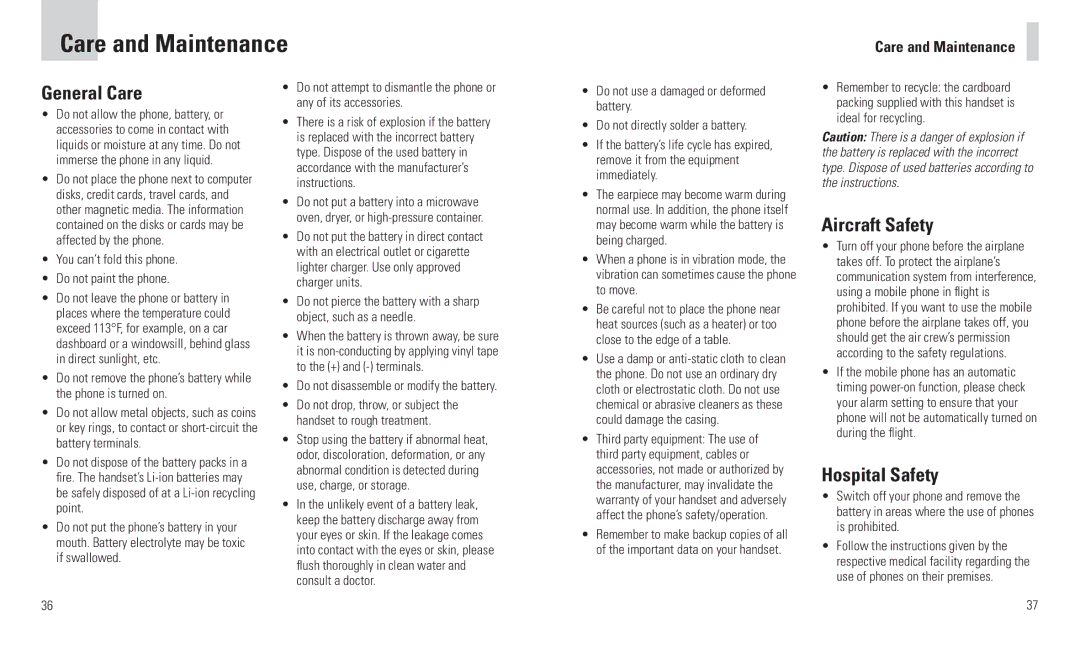Care and Maintenance
Care and Maintenance
General Care
•Do not allow the phone, battery, or accessories to come in contact with liquids or moisture at any time. Do not immerse the phone in any liquid.
•Do not place the phone next to computer disks, credit cards, travel cards, and other magnetic media. The information contained on the disks or cards may be affected by the phone.
•You can’t fold this phone.
•Do not paint the phone.
•Do not leave the phone or battery in places where the temperature could exceed 113°F, for example, on a car dashboard or a windowsill, behind glass in direct sunlight, etc.
•Do not remove the phone’s battery while the phone is turned on.
•Do not allow metal objects, such as coins or key rings, to contact or
•Do not dispose of the battery packs in a fire. The handset’s
•Do not put the phone’s battery in your mouth. Battery electrolyte may be toxic if swallowed.
36
•Do not attempt to dismantle the phone or any of its accessories.
•There is a risk of explosion if the battery is replaced with the incorrect battery type. Dispose of the used battery in accordance with the manufacturer’s instructions.
•Do not put a battery into a microwave oven, dryer, or
•Do not put the battery in direct contact with an electrical outlet or cigarette lighter charger. Use only approved charger units.
•Do not pierce the battery with a sharp object, such as a needle.
•When the battery is thrown away, be sure it is
•Do not disassemble or modify the battery.
•Do not drop, throw, or subject the handset to rough treatment.
•Stop using the battery if abnormal heat, odor, discoloration, deformation, or any abnormal condition is detected during use, charge, or storage.
•In the unlikely event of a battery leak, keep the battery discharge away from your eyes or skin. If the leakage comes into contact with the eyes or skin, please flush thoroughly in clean water and consult a doctor.
•Do not use a damaged or deformed battery.
•Do not directly solder a battery.
•If the battery’s life cycle has expired, remove it from the equipment immediately.
•The earpiece may become warm during normal use. In addition, the phone itself may become warm while the battery is being charged.
•When a phone is in vibration mode, the vibration can sometimes cause the phone to move.
•Be careful not to place the phone near heat sources (such as a heater) or too close to the edge of a table.
•Use a damp or
•Third party equipment: The use of third party equipment, cables or accessories, not made or authorized by the manufacturer, may invalidate the warranty of your handset and adversely affect the phone’s safety/operation.
•Remember to make backup copies of all of the important data on your handset.
•Remember to recycle: the cardboard packing supplied with this handset is ideal for recycling.
Caution: There is a danger of explosion if the battery is replaced with the incorrect type. Dispose of used batteries according to the instructions.
Aircraft Safety
•Turn off your phone before the airplane takes off. To protect the airplane’s communication system from interference, using a mobile phone in flight is prohibited. If you want to use the mobile phone before the airplane takes off, you should get the air crew’s permission according to the safety regulations.
•If the mobile phone has an automatic timing
Hospital Safety
•Switch off your phone and remove the battery in areas where the use of phones is prohibited.
•Follow the instructions given by the respective medical facility regarding the use of phones on their premises.
37
